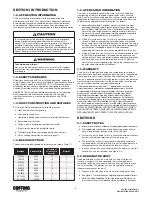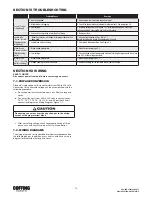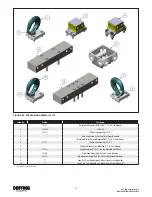
19
EC3-680-3 February 2017
Order # 5041558-0 & 5041679-0
SECTION VI TROUBLESHOOTING
Problem
Probable Cause
Remedy
Lack of Proper
Lifting Speed.
1. Hoist overloaded.
1. Reduce load to within rated capacity of hoist.
2. Motor brake is dragging.
2. Check for proper brake adjustment or other defects. Sec paragraph 5-3.
3. Low voltage.
3. Bring up voltage to plus or minus 10% of voltage specified on hoist. Line
voltage should be measured while hoist is lifting load.
4. Overload limiting clutch intermittently slipping.
4. Replace clutch,
Load Brake
“Noise.” (Erratic
tapping sounds
or squeals)
1 . Need transmission oil change, or improper lubricant has
been used.
1. Change transmission oil. Sec Table 5-1.
Note: Hoist Warranty is void if unapproved oil is used.
2. Load brake malfunctioning.
2. Check load brake operation. See Figure 4-3.
Motor Brake
Noise or Chatter.
(While starting
hoist)
1. Brake needs adjustment.
1. Adjust as per paragraph 5-3.
2. Low voltage.
2. Check voltage at hoist power cord with hoist starting. Voltage should be no less
than 90% of the voltage specified.
Motor Brake
“Buzz.” (Anytime
hoist is running)
1. Brake needs adjustment.
1. Adjust as per paragraph 5-3.
2. Broken shading coil on brake frame.
2. Replace shading coil or complete brake frame assembly.
SECTION VII WIRING
SAFETY NOTES
Disconnect power from hoist before removing end covers.
7-1.VOLTAGE CONVERSION
Standard single speed units are convertible from 460 to 230 volts.
Conversion to the alternate voltage can be accomplished with the
following procedure.
a. Be sure power is disconnected from hoist. Remove long end
cover.
b. To convert the hoist from 460 to 230 volts, reconnect leads
T4, T5 , T6, T7, T8, T9, H2, H4, SI, and S2 per the 230 volt
connection diagram on Wiring Diagram, Figure 7-1.
Do not move any wires or make any changes to the wiring
except at the gray terminal block.
c. After converting voltage, check for proper phasing of three
phase units and check for proper limit switch operation.
7-2. WIRING DIAGRAMS
The wiring diagrams for standard hoist models are reproduced on
the following pages. In addition, every hoist should have a wiring
diagram located inside the long end cover.









































